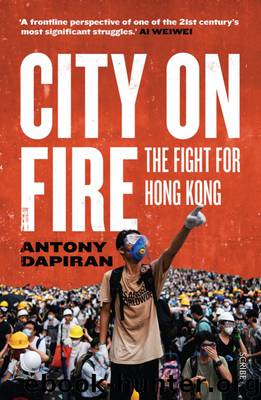City on Fire by Antony Dapiran

Author:Antony Dapiran
Language: eng
Format: epub
Tags: POL054000, POL054000, POL007000, POL004000, POL062000, HIS054000, HIS008000
Publisher: Scribe Publications Pty Ltd
Published: 2020-03-02T16:00:00+00:00
In the meantime, the collective brow of Hong Kong was furrowed by a pair of cryptic front-page newspaper advertisements that appeared in two leading Chinese-language papers on the morning of Friday 16 August, signed in the name of ‘A Hong Kong citizen: Li Ka-shing.’ Li, now ninety-one years old, had been known for his close relationship with former president Jiang Zemin. Under Jiang’s watch, Li had been allowed to purchase a mammoth real-estate development site on the corner of Chang’an Avenue and Beijing’s main commercial street, Wangfujing. Jiang, it was commonly believed, had also come to Li’s assistance when Li’s son Victor was kidnapped by a notorious Hong Kong gangster, ‘Big Spender’ Cheung Tze-keung. Li quietly paid the HK$1 billion ransom Big Spender demanded, and did not pursue the case with the Hong Kong police. But two years later, Big Spender was arrested on the mainland and — in spite of concerns over a Hong Kong resident being tried in the mainland for crimes committed in Hong Kong, and with attempts to have him extradited back to Hong Kong unsuccessful — he was found guilty, and executed.
Jiang’s ‘Shanghai clique’ party faction was politically opposed to the ‘princeling’ Xi Jinping. As Xi assumed power, Li had steadily divested himself of his business interests in mainland China and diversified his business globally. Now Li was seen as a potential ally by protesters, who began parsing his messages, looking for coded signs of support. They soon found what they were looking for.
The first advertisement contained a quotation from a Tang Dynasty poem: ‘The melon of Huangtai cannot bear to be picked any further,’ meaning that something has suffered so much that any further attack would ruin it.7 This was not the first time Li had used the quotation to respond to questions about politics, and its ambiguous nature served his purposes well. This time, readers could be forgiven for wondering, Who does Li think is doing the ruining?
The second advertisement carried a more straightforward message with bold characters reading, ‘No Violence.’ However, the accompanying headline, ‘The Best Intentions Can Lead to the Worst Outcome’, was once again ambiguous. Whose intentions was Li referring to — those of Lam, or the protesters? Protesters were further cheered when picking out the final characters of each line of Li’s advertisement gave them the message: ‘The blame lies with the nation. Let Hong Kong rule itself.’8
Regardless of whether Li was deliberately sending coded messages of support or otherwise, his was a voice that commanded some moral authority in the community, and the fact that he chose to speak out at this crucial time was significant, possibly helping to restore the balance of sentiment back to equilibrium at a time when it threatened to collapse entirely.
A few weeks later, Li was captured on video urging political leaders to offer an olive branch to the young protesters. In response, Beijing’s Central Political and Legal Affairs Commission published a post on social media accusing Li of ‘condoning crime’, and a pro-Beijing politician in Hong Kong branded Li the ‘king of cockroaches’.
Download
This site does not store any files on its server. We only index and link to content provided by other sites. Please contact the content providers to delete copyright contents if any and email us, we'll remove relevant links or contents immediately.
| Anarchism | Communism & Socialism |
| Conservatism & Liberalism | Democracy |
| Fascism | Libertarianism |
| Nationalism | Radicalism |
| Utopian |
The Secret History by Donna Tartt(16710)
The Social Justice Warrior Handbook by Lisa De Pasquale(11503)
Thirteen Reasons Why by Jay Asher(7825)
This Is How You Lose Her by Junot Diaz(5821)
Weapons of Math Destruction by Cathy O'Neil(5070)
Zero to One by Peter Thiel(4861)
The Myth of the Strong Leader by Archie Brown(4806)
Promise Me, Dad by Joe Biden(4473)
Beartown by Fredrik Backman(4460)
How Democracies Die by Steven Levitsky & Daniel Ziblatt(4440)
Stone's Rules by Roger Stone(4434)
The Fire Next Time by James Baldwin(4366)
100 Deadly Skills by Clint Emerson(4103)
A Higher Loyalty: Truth, Lies, and Leadership by James Comey(4052)
Rise and Kill First by Ronen Bergman(4038)
The David Icke Guide to the Global Conspiracy (and how to end it) by David Icke(3908)
The Farm by Tom Rob Smith(3890)
Secrecy World by Jake Bernstein(3801)
The Doomsday Machine by Daniel Ellsberg(3750)
